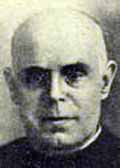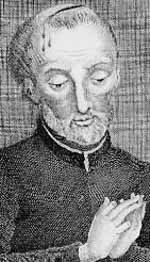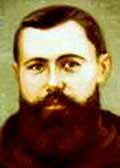


Blessed Anicet Adalbert (Wojciech Anicet) Koplinski, Priest and Martyr
Debrzyno, Poland, July 30, 1875 – Auschwitz, Poland, October 16, 1941
Father Aniceto (born Wojciech Koplinski), Capuchin priest born in Debrzyno (Poland) on July 30, 1875, while the Polish homeland was in the hands of German invaders, were deported to the concentration camp of Auschwitz where they died entrrambi October 16, 1941, the first in the gas chamber and the second killed by the captors instead of the field.
And from the end of a life that often receives its light. This finding is doubly true for a man who, on June 13, 1999 in Warsaw was proclaimed blessed by Pope John Paul II during his eighth trip to Poland. This man would have remained unknown had he not come to the altars. But his story sheds yet another light in both dark chapter of German history this century. And even in human affairs, its purpose was obvious who and for what is experienced.
We’re talking about Anicet Koplinski, a Capuchin who so far escaped the chronicles of the world. Born June 30, 1875 in Preußisch-Friedland (now Gmina Debrzno) in the province of West Prussia in Germany, a city bordering with Poland where he was also a strong presence in Poland.
Strong relations in particular, were among the few German Catholics in the area and the group of Poles, mainly because of their common Catholic faith, which gave them the opportunity to participate in the same liturgies and also share the same jobs. The small Adalbert, the name that was imposed in baptism, was the youngest of 12 brothers, a far from wealthy family who made their living with the father’s salary worker. Adalbert, or simply Albert, as everyone called him, also met the Capuchins known at that time for their social apostolate and also had direct experience with them in his youth. On November 23, 1893 he came back in the Capuchin convent in Sigolsheim nell’Alsazia (in Prussia all the Capuchin monastery had been suppressed) belonging to the province Rhine-Westphalia, and received the name of Aniceto (invincible).
The day of the Assumption in 1900 he was ordained a priest and then to perform his ministry primarily in Dieburg, then along in the Ruhr (Werne, Sterkrade, Krefeld) as assistant to the Polish people. At home, he actually had a little Polish study now improved and he had personally during the years of study, using even after the period of leave at his sister who lived in Poland to spend time in a Polish environment. In his apostolate in the Ruhr area his knowledge of the Polish language was very useful, as well as its origin from a family of laborers. He could understand working people, and vice versa, they understood him. This emotional closeness to Poland, did not diminish his love for Germany; he was a man of the frontier, but also a patriot. At the beginning of the outbreak of World War I he composed a poem for the war, compositions that embarrass us today. But even this later put his poetic ability to serve the poor who increasingly became the only goal of his pastoral work.
The turning point in the life of Fr Aniceto was in 1918 in Krefeld when he was given the request to make himself available for the reorganization of church life and the Order in Warsaw. Enthusiastically he accepted this challenge. After long years of Tsarist rule, Poland had regained its freedom. But the economic situation was disastrous, and many were poor and families living in poverty. Nor were there a great many rich, as we see today in different situations in countries such as Brazil, Mexico, India. P. Aniceto became a mediator between these two groups. Without asking anything for himself, always with his poor habit and sandals, he was seen walking the streets of Warsaw to beg for the poor. And what he could get was pinned into the deep pockets of his coat: bread, sausage, fruit, vegetables, sweets for the children. Often he carried it upon his shoulders, or dragged heavy parcels or large suitcases full of basic necessities. On January 25, 1928 he wrote to his provincial Father Ignatius Ruppert, “A particular challenge, which is often a heavy work for me are the many poor and many people here without work for which nearly every day I go out for alms.” He was described as “St. Francis of Warsaw.”
It is not far from the truth if one interprets his work as an alms for the poor as an expression of sporting activity.
Since his youth he had practiced daily lifting of weights. At the prayer of midnight, a tradition that every monk began in the novitiate, he, before the prayer or after returning to the room, he practiced in his specialty. His perseverance led him to a big muscle power so he could do extraordinary things with the joy of his brothers or for the benefit of the poor or even of pastoral service. So he set up tables and benches or showed his skills in the village fairs and then go with the “hat” (skullcap), asking for a reward for the poor. It is said that a police officer who acted violently with his wife and his children, despite his repeated confessions, was unable to improve his aggressive character. One day father Aniceto took him to the sacristy, grabbed his belt and lifted it above his head shouting, “See what you can, and what God will do with you if you continue to be so violent?”. The lesson was effective, the policeman broke free from his violence.
When Father Anicet was not around for the poor, he often sat in the confessional of the Capuchin Church in Warsaw. Each morning he began to take confessions one hour before the Mass and remained there for the next hour, and again in the evening, when he returned to the convent from his begging. He did this work more readily than preach, request that the latter was addressed only infrequently by the superior, because of his limited knowledge of Polish.
For many priests who came to his confessional he gave brief but very effective warnings in Latin, he was chosen as confessor Gawlina Gall and by the bishops, and even by the cardinal and the papal nuncio Kakowski Achille Ratti, the future Pope Pius XI. Normally required to do penance as alms for the poor, penance also given to Cardinal Kakowski which ordered him to donate during the winter time a car of coal for a poor family.
Father Aniceto took care of the soul and the body of others. Asked the rich for bread for the poor, but called the poor to pray for themselves and for the rich “before God takes responsibility for each other. Of great significance was seen in front of his confessiona:: army officers next to the peasants, elegant women near poor widows. The Capuchin had the same love for all. The news that someone was dying made him run to his bedside to comfort him and bring him the sacraments of confession and communion. And if someone died, abandoned by all, he took care of the burial. He often took part in the funeral rites and procession to the cemetery, praying his breviary on the road or the rosary, and sometimes it happened that so great was his immersion in God that he did notice the entry of the cemetery as the procession moved beyond Funeral turn toward the cemetery.
Aniceto Koplinski was of German nationality. He did not hide it, even when the politics of Hitler had begun to be unacceptable. When he was arguing with his brother he often beat his fists against the table talking about the political events in Germany. He saw and understood the spirit of National Socialism and its anti-Christian demonic vision of the world. Aniceto could not come to terms with this current policy. Having experienced since his youth, honesty and faith of the Polish people, he could not stand on their side, to assume, motivated by a radical solidarity, the name of Koplinski. During the first week of German occupation in Poland, he remained in the convent. But soon he was seen engaged in providing assistance to its poor and even those who had to flee because of Nazi violence. From the Germans, using his knowledge of German, he obtained the necessary permits to obtain food, clothing, shoes and medicine. The father Koplinski also strove for non-Catholic Christians and Jews, as testified by the Archbishop Niemira.
For the Gestapo and the Capuchins in particular p. Koplinski were smoke and mirrors. Ascension Day of 1941 took place the first interrogation. The Capuchin Prussian, without fear and frankly, as was his custom, expressed a very heavy thought: “After what Hitler did to Poland, I am ashamed to be a German.” The Capuchin Father could have saved his life, if he had appealed to his German citizenship. This way out, then that would have contradicted the sincerity and spirit of sacrifice that marked his person. The fact is that on June 28, 1941, the day after the air strike in Warsaw, he was arrested along with 20 other brothers and thrown into prison Pawiak. The reason for the arrest was to have read propaganda sheet antinazionalsocialisti and expressing ideas contrary to the new regime.
After he wasrrested his hair and beard were shaved, and even stripped of his religious clothing, but he was allowed to retain his breviary. The Father Superior and Fr Aniceto were tortured to force them to incriminate others, but could not tear their admission that he had incited people to rebellion against the regime. He remained faithful to hisvocation as a religious and a priest, even in the face of threats and reprisals, it is faith openly declared during interrogation: “I am a priest and wherever there are men, I am working: whether they are Jews, Poles, and especially if the suffering and poor. “
On September 3 they were all loaded into a cattle car to be transported to Auschwitz, where they received the much infamous striped jacket and a number of prisoners. Human dignity had been snatched from them; they were among thousands of prisoners to be reduced to a number. At 66, P. Aniceto was used in the block of the disabled, which in turn was close to that of the intended extermination. We do not know very well what he had to endure harassment and abuse during the five weeks that followed, but we are a bit ‘reconstructed from the stories reported that the survivors. We have, however, the direct testimony of his Provincial and fellow prisoner Father Archangel, who said that “Fr Aniceto, newly arrived at the entrance of the camp, was beaten because he could not keep pace with the others, beyond that, he was even bitten by a dog in the SS. During the call the Capuchin monk was put together older people and those who could not work and placed in the block close to that of being destined to death. Throughout this period of suffering Fr Anicet prayed and kept quiet, keeping constant the peace and quiet. “
This testimony is sufficient to make us see that the Capuchin Father, often after having celebrated the Via Crucis and helped others to carry their cross behind Jesus lived this tragic moment of his life to Jesus and united as a painful path to Golgotha. One who not so long ago he had shouted to defend the poor and condemn the sin, now remained silent and prayed. Before being led to the gas chamber, he said to a friend: “We drink to the bottom of the cup.”
On 16 October the captors set up after a short trial, threw Fr Anicet along with other prisoners in a pit and threw them lime, and a painful death, because the lime gives off a violent corrosive activity on living bodies to consume like fire.
After having lived poor and he had undertaken for the poor, Aniceto Koplinski met his maker, dying in absolute poverty.
On the outside was also stripped of everything of the flesh, but inside was filled with a treasure that nobody ever would have been able to wrest faith, dignity and loving attention to others. He died in the hope of resurrection and faith that his suffering and cruel death is an aid to reconcile the divided soul of Germany and Poland, the Jews and the Christians, Catholics and Protestants, the poor and the rich.
Source: The Holy See



 Posted by naniam
Posted by naniam 































